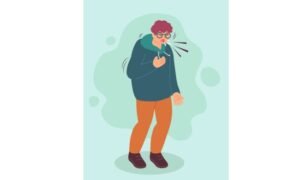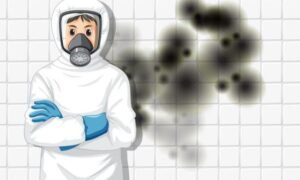Mold is a type of fungus that thrives in damp and humid environments. While it might seem harmless, exposure to mold can lead to health issues, especially when it releases tiny spores into the air. Mold toxicity, also known as mold illness or mycotoxicosis, can affect people differently. Understanding the 10 warning signs of mold toxicity can help in early detection and seeking proper medical attention.
What Is Mold?
Mold is a type of fungus that can be found indoors and outdoors. It flourishes in damp, warm, and humid environments. It usually spreads through tiny spores that are invisible to the naked eye. It can grow on various surfaces, including walls, ceilings, carpets, and even food.
What Is Mold Toxicity?
Mold toxicity, also known as mold illness or mold-related illness, occurs when a person inhales or comes into contact with mold spores, leading to a range of health issues. Exposure to certain types of mold can cause adverse reactions in some individuals.
Long-Term Effects of Mold Exposure
- Prolonged exposure to mold can lead to chronic health problems such as respiratory infections, asthma exacerbation, and in severe cases, mold-related illnesses.
- It can worsen existing health conditions and cause complications in vulnerable individuals.
10 Warning Signs of Mold Toxicity
Recognizing the signs and symptoms can help in identifying potential mold-related health issues. If any of the warning signs mentioned below persist or worsen you should immediately consult a doctor for proper diagnosis and treatment.
1. Respiratory Issues:
Mold exposure can lead to various respiratory symptoms:
- Coughing: Mold spores, when inhaled, can irritate the respiratory tract, leading to persistent coughing.
- Wheezing: Some individuals may experience a whistling or squeaky sound while breathing due to constriction in the airways caused by mold exposure.
- Shortness of Breath: Mold-induced inflammation in the lungs or airways can result in difficulty breathing or feeling breathless, even with minimal exertion.
- Congestion: Mold exposure can lead to nasal congestion or a feeling of blockage in the nasal passages.
- Sinusitis: Inflammation of the sinuses caused by mold spores can result in symptoms like facial pain, pressure, and sinus congestion.
2. Allergic Reactions:
Mold exposure can prompt allergic responses in following ways:
- Sneezing: Mold spores can trigger the body’s immune response, causing repeated sneezing as a way to expel these irritants from the nasal passages.
- Runny or Stuffy Nose: Irritation from mold spores can lead to increased mucus production, resulting in a runny or congested nose.
- Itchy or Watery Eyes: Exposure to mold can cause an allergic reaction in the eyes, leading to itching, redness, and excessive tearing.
- Skin Rashes or Hives: Some individuals may develop skin reactions such as rashes or hives upon contact with mold or its spores.
3. Fatigue and Weakness:
Individuals might experience following symptoms:
- Persistent Fatigue: Mold toxicity can cause chronic fatigue, leaving individuals feeling tired even after getting adequate rest.
- Lack of Energy: Individuals may experience a general sense of weakness or a lack of energy to perform daily activities.
- Difficulty Concentrating: Mold exposure might impact cognitive abilities, making it challenging to focus or concentrate on tasks.
4. Headaches:
- Recurrent Headaches: Exposure to mold can trigger frequent headaches or migraines in affected individuals.
- Pressure or Tightness in the Head: Some people may experience a sensation of pressure or tightness in the head due to mold-related inflammation or irritation.
5. Digestive Issues:
Digestive disturbances can arise due to mold exposure, resulting in:
- Nausea: Mold toxicity may lead to feelings of nausea or queasiness, sometimes accompanied by a sensation of wanting to vomit.
- Diarrhea: Exposure to mold can sometimes result in digestive disturbances, causing loose or watery stools.
- Abdominal Pain or Discomfort: Some individuals may experience stomach discomfort or pain associated with mold exposure.
6. Joint Pain:
Mold exposure might result in joint discomfort. Symptoms might manifest as:
- Aching Joints: Mold toxicity might contribute to joint pain or discomfort, affecting mobility and causing discomfort in the joints.
- Muscle Pain or Cramps: Individuals exposed to mold might experience muscle pain or cramps as a result of the body’s inflammatory response.
- Stiffness: Mold-related inflammation can lead to stiffness in muscles or joints, affecting flexibility and movement.
7. Neurological Symptoms:
Individuals may experience following neurological symptoms:
- Dizziness: Mold exposure can sometimes lead to feelings of lightheadedness or a sensation of spinning (vertigo).
- Difficulty Balancing: Some individuals may experience problems with balance or coordination due to neurological effects from mold toxicity.
- Tingling or Numbness: Mold-related neurological symptoms might include sensations like tingling or numbness in certain body parts.
8. Sensitivity to Light:
Mold toxicity can cause increased sensitivity to light. Affected individuals may experience following symptoms:
- Eyes More Sensitive to Light: Mold exposure might cause increased sensitivity of the eyes to light, leading to discomfort in bright environments.
- Squinting or Discomfort in Bright Light: Affected individuals might find themselves squinting or feeling discomfort in well-lit areas.
9. Changes in Mood:
Changes in mood can manifest in following ways:
- Anxiety: Mold toxicity can sometimes contribute to feelings of nervousness or unease.
- Depression: Prolonged exposure to mold may affect mood, leading to feelings of sadness or depression.
- Irritability: Mold-related symptoms might include increased irritability or a shorter temper than usual.
10. Unexplained Weight Gain or Loss:
Mold toxicity might, in some cases, lead to unexplained fluctuations in weight, either gain or loss, without changes in diet or exercise habits.
Who is at Risk of Mold Toxicity?
Anyone can experience mold toxicity, but certain factors can increase the risk:
- Living in Damp Conditions: Residing in areas with excessive moisture or water damage.
- Weakened Immune System: Individuals with weakened immune systems, such as those with HIV/AIDS or undergoing chemotherapy.
- Respiratory Conditions: People with asthma, allergies, or other respiratory issues may be more sensitive to mold.
- Occupational Exposure: Those working in environments prone to mold, like construction, agriculture, or mold remediation.
How to Manage Mold Toxicity?
Treatment of mold toxicity involves a multi-faceted approach that includes medical evaluation, symptom management, environmental changes, and, in severe cases, professional mold remediation. It is important to seek medical advice for proper diagnosis and personalized treatment based on individual symptoms and health conditions. Following are some measures that can be done in case of mold toxicity:
- Seek Medical Evaluation:
If you suspect mold toxicity or experience persistent symptoms related to mold exposure, consult a healthcare professional. A doctor can perform a thorough evaluation, consider your symptoms, and conduct tests to diagnose mold-related illnesses.
- Avoid Further Exposure:
Limit or completely avoid exposure to mold or areas with visible mold growth to prevent worsening of symptoms. Stay away from damp or musty environments that might trigger allergic reactions or exacerbate existing symptoms.
- Medication and Symptom Management:
Doctors may prescribe medications to alleviate symptoms associated with mold toxicity. Antihistamines, decongestants, nasal corticosteroids, or bronchodilators might be prescribed based on the specific symptoms experienced by the individual.
- Address Respiratory Issues:
For respiratory symptoms like coughing, wheezing, or congestion, doctors may recommend inhalers or other respiratory therapies to ease breathing difficulties.
- Treat Skin Reactions:
Skin reactions such as rashes or hives due to mold exposure can be managed with topical creams, antihistamines, or other medications as advised by a healthcare provider.
- Allergy Management:
Individuals with mold allergies might benefit from allergy medications or immunotherapy (allergy shots) to reduce allergic reactions triggered by mold exposure.
- Supportive Therapies:
Supportive therapies like breathing exercises, physical therapy, or counseling might be recommended to manage symptoms such as fatigue, joint pain, or mood changes.
- Environmental Changes:
Improve indoor air quality by using air purifiers with HEPA filters to reduce airborne mold spores. Implement measures to prevent further mold growth by addressing moisture issues and fixing leaks.
- Professional Mold Remediation:
In cases of extensive mold infestation or if mold is difficult to remove, consider hiring certified professionals for mold remediation. Mold remediation experts use specialized equipment and techniques to safely remove mold and prevent its recurrence.
- Follow-Up Care:
Attend follow-up appointments with healthcare providers to monitor progress, adjust treatment plans if needed, and ensure proper management of mold-related health issues.
How to Prevent Mold Toxicity?
Prevention is the best way to manage mold toxicity. Here are some steps to reduce exposure:
1. Maintain Proper Ventilation:
- Ensure good airflow throughout your home or workplace by using exhaust fans in bathrooms, kitchens, and laundry areas.
- Open windows and doors whenever possible to improve ventilation and reduce humidity levels.
2. Control Moisture:
- Repair leaks promptly. Inspect and fix any leaks in roofs, pipes, or walls to prevent moisture buildup.
- Use waterproof materials in areas prone to moisture, like bathrooms and basements, and replace damaged materials.
3. Monitor Humidity Levels:
- Use a hygrometer to measure indoor humidity levels. Keep humidity between 30-50%. Consider using dehumidifiers in damp areas.
- Empty and clean drip pans in air conditioners, refrigerators, and dehumidifiers regularly to prevent mold growth.
4. Regular Cleaning and Maintenance:
- Clean and dry areas prone to moisture regularly, including bathrooms, kitchens, and window sills.
- Regularly clean and maintain HVAC systems to prevent mold growth in ducts and vents.
5. Use Mold-Resistant Products:
- Consider using mold-resistant paints, drywall, and other construction materials in areas susceptible to mold growth.
- Choose moisture-resistant carpets and fabrics to minimize mold growth in these materials.
6. Reduce Clutter:
Keep your living and working spaces clutter-free. Clutter can trap moisture and hinder proper ventilation, promoting mold growth.
7. Properly Dry Wet Areas:
Address spills, leaks, or flooding promptly. Thoroughly dry wet areas and items within 24-48 hours to prevent mold growth.
8. Inspect and Maintain Outdoor Areas:
- Regularly clean gutters and downspouts to ensure proper drainage and prevent water accumulation around the foundation of your home.
- Trim trees and bushes near your home to allow proper airflow and prevent excess moisture.
9. Use Air Purifiers with HEPA Filters:
Consider using air purifiers equipped with High-Efficiency Particulate Air (HEPA) filters to capture mold spores and other airborne particles.
10. Regular Inspections and Maintenance:
- Conduct routine inspections of your home or workplace for signs of mold growth or water damage.
- Address any mold issues promptly by cleaning affected areas or seeking professional mold remediation if necessary.
11. Personal Protection:
When cleaning moldy areas, wear protective gear such as gloves, masks, and goggles to prevent direct exposure to mold spores.
12. Seek Professional Assistance:
If you suspect extensive mold growth or are unsure about handling mold-related issues, consider hiring certified professionals for mold inspection, testing, and remediation.
The Bottom Line
Early identification of the 10 warning signs of mold toxicity and taking effective measures to prevent and address mold issues are crucial for maintaining a healthy living environment. By staying informed, practicing preventive measures, and prioritizing a clean and dry living space, individuals can significantly reduce the risks associated with mold toxicity and safeguard their health and well-being.
For any further query feel free to contact us at https://medicalinquiries.com/contact-us/



